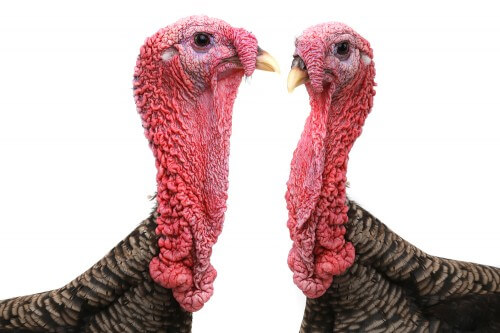When a turkey is angry or excited, the color of its head changes from red to white and blue. Engineers at the University of Berkeley think this mechanism could be used to make innovative sensors for detecting volatile substances. How do they do it?

By: Ofir Marom
When a turkey is angry or excited, the color of its head changes from red to white and blue. Engineers at the University of Berkeley think this mechanism could be used to make innovative sensors for detecting volatile substances. How do they do it?
Turkeys are birds with a large body and a small head. The rooster's head and neck are bald. This area is covered with loose and wrinkled skin, and through its beak and along the rooster's neck, a leather bag, which is usually red in color, hangs down. Sometimes the turkey flaps its wings vigorously, and the skin folds turn from red to blue and white due to the blood flow. This phenomenon is made possible thanks to a dense array of blood vessels within which bundles of collagen fibers are interwoven. The researchers claim that the space between the collagen fibers changes when the blood vessels swell or contract, depending on whether the bird is excited or angry... The sum of the spaces between the fibers changes the way light waves are scattered, and this changes the colors of the rooster's head as we see them. A research group from the University of Berkeley, led by Professor Seung-Wuk Lee (Seung-Wuk Lee), was able to imitate the ability of turkeys to change color to build sensors that can detect volatile chemical substances.
Sensors that work by changing color are more convenient to use and read than conventional biological sensors based on other technologies. However, other sensors of this type developed in the world can only detect a limited variety of chemical substances, and according to the researchers, they can be very difficult to manufacture. "Our system is convenient, and cheap to build," asserts Professor Lee. With the help of the developed system, the researchers claim, smart phones adapted for this will be able to identify a chemical substance.
To shape the chicken skin artificially, the team of researchers developed an innovative technique to build nanostructures similar to the collagen fibers. The researchers found a way to make M13 bacteriophages, benign viruses with a shape that closely resembles collagen fibers, self-organize into patterns that can be programmed in advance. The researchers found that like collagen fibers, bundles of these synthetic nanostructures expanded and contracted and thus changed color. However, the exact mechanism for this phenomenon is still unclear. It is believed that the small amount of water inside the bacteriophages reacts to the molecules of the volatile substances.
The new biological sensor was exposed to a wide range of volatile organic compounds as well as vapors of the explosive TNT, in concentrations of up to 300 ppb (parts per billion). The researchers found that the viruses swelled rapidly, and as a result, specific color patterns were created that served as "fingerprints", making it possible to distinguish between the different chemicals tested. The researchers also showed that it is possible to increase the sensitivity of the sensor to specific substances by genetically modifying the DNA of the M13 bacteriophage. It was also found that the sensor can also give an indication of changes in relative humidity, by turning red when the air is moist and bluer when the air is dry.
In Israel we ask the turkeys when Purim is. In the USA, every year, the president gifts a turkey at Thanksgiving, and in Japan and Korea they are called the "seven-faced bird" due to their ability to change color. In the future, the researchers hope that the technology developed inspired by this multi-faceted bird will develop and mature so that it can be used for breath tests to detect cancer and other diseases.
